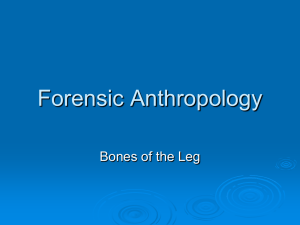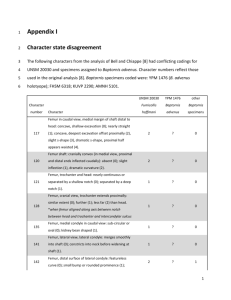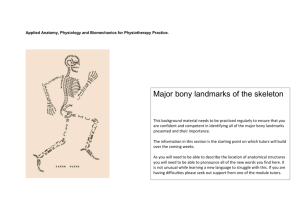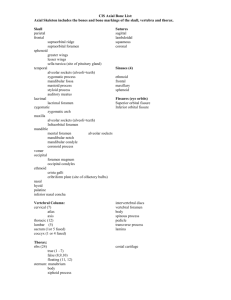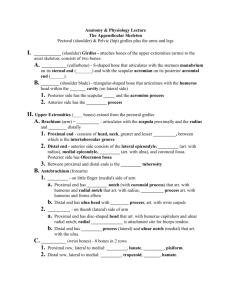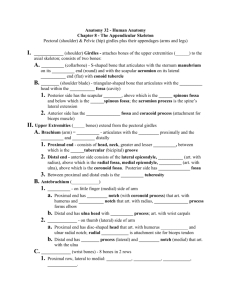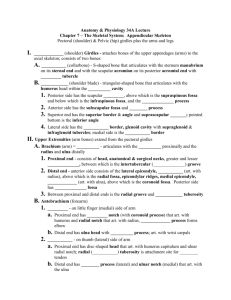Foundations of Functional Anatomy for Physiotherapy Practice Major
advertisement
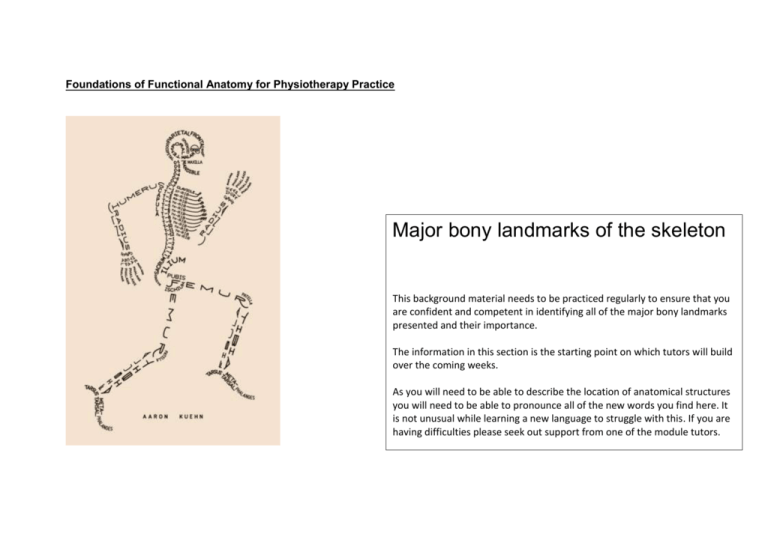
Foundations of Functional Anatomy for Physiotherapy Practice Major bony landmarks of the skeleton This background material needs to be practiced regularly to ensure that you are confident and competent in identifying all of the major bony landmarks presented and their importance. The information in this section is the starting point on which tutors will build over the coming weeks. As you will need to be able to describe the location of anatomical structures you will need to be able to pronounce all of the new words you find here. It is not unusual while learning a new language to struggle with this. If you are having difficulties please seek out support from one of the module tutors. Major Bony Landmarks The pelvis a. The iliac crest forms the distal attachment point for several major muscles of the trunk b. This anterior surface of the ilium is the iliac fossa which is the proximal attachment point for iliacus one of the flexor muscles of the hip. The posterior surface of the ilium is the proximal attachment point for all three of the gluteal muscles. c. Is the anterior superior iliac crest (ASIS). This is easily palpated on most people and is the proximal attachment point of the muscle sartoruis d. Lying below the ASIS is the anterior inferior iliac crest (AIIS) which forms the proximal attachment point of rectus femoris one of the quadriceps muscle group e. Is the ischial tuberosity on the posterior aspect of the pelvis. This is the proximal attachment point for the three muscles that make up the hamstring group. f. Is the pubic tubercle NB the symphysis pubis is the cartilaginous joint that joins the pelvis anteriorly between the two pubic bones. g. Is the sacrum which sits between the two ilia to form the large stable sacroiliac joints on the posterior aspect of the pelvis The 5 lumbar vertebra are stacked above the sacrum. The 5th (L5) has local ligament attachments the sacrum and the ilium Self Check The Pelvis Bony Feature Identification of the skeleton Identification on a model The iliac crest The iliac fossa N/A Anterior superior iliac spine Anterior inferior iliac spine Ischial tuberosity Pubic tubercle The sacrum The coccyx 5th lumbar vertebra N/A Clinical relevance Major Bony Features of the Lower Limb 1 The Anterior Femur a. The head of the femur Ball of the hip joint it articulates with the acetabulum of the pelvis. It has a fossa in the middle (fovea capitis) b. Neck of the femur – Angled to increase the range of movement of the hip – The angle is more acute in women – It is a common site of osteoporosis resulting in a high risk for fracture in fall in the elderly – It is the distal attachment site of the hip capsule c. Greater trochanter a. The attachment site for the gluteal muscles (Gluteus Maximus, Medius and minimus d d. Lesser trochanter a. The attachment point for the psoas muscles and iliacus Inter-trochanteric line passes across the anterior surface between the two trochanters. It is the site of the distal attachment of the iliofemoral ligament of the hip e Lateral epicondyle of the distal femur – proximal attachment of the lateral collateral ligament of the knee f Medial epicondyle of the distal femur – proximal attachment of the medial collateral ligament of the knee g Adductor tubercle on the superior part of the medical epicondyle– the distal attachment point of the adductor magnus muscle Self Check: Femur Bony Feature Identified on the skeleton Identified on a model Head of the femur N/A Neck of the femur N/A Greater trochanter Lesser trochanter N/A Inter trochanteric line N/A Lateral epicondyle of the femur Medial epicondyle of the femur The adductor tubercle Knowledge of the significance The Posterior Femur h The gluteal tuberosity – distal attachment point for the deep fibres of the gluteus maximus i The intertrochanteric crest j The linea aspera – this raised ridge running down the posterior aspect of the femur is a site of attachment for several major muscles the quadriceps muscles vastus medialis and vastus lateralis before they wrap round the femur the adductor muscles (adductor magnus, adductor longus and adductor brevis) the short head of the biceps femoris one of the hamstring muscles k The lateral and medial supracondylar lines l The lateral condyle of the femur – articulates with the flattened lateral condyle of the tibia the medial surface of this condyle is the attachment point of the anterior cruciate ligament of the knee m The medial condyle of the femur – articulates with the flattened medical condyle of the tibia. The lateral surface of this condyle is the attachment point of the posterior cruciate ligament of the knee n The intercondylar notch Self Check Femur cont. Bony Feature Identified on the skeleton Identified on a model The gluteal tuberosity N/A Intertrochanteric crest N/A Linea aspera N/A Lateral and medial supracondylar lines N/A Lateral condyle of the femur Medial condyle of the femur The intercondylar notch Major Bony Features of the Lower Limb 2: The Tibia and fibula N/A Knowledge of the significance Tibia and Fibula Anterior View A The tibial spine. The anterior part of the intercondylar ridge (this raised area divides the tibial plateau into the lateral and medial articular surfaces. This point is also the distal (anterior) attachment of the anterior cruciate ligament B The lateral condyle of the tibia – distal attachment of the iliotibial band C The head of the fibula – distal attachment of the lateral collateral ligament of the knee – distal attachment of the biceps femoris muscle (one of the hamstrings) The superior tibiofibular joint is formed between the medial side head of the fibula and the under surface of the lateral tibial condyle. (This is a synovial plane joint) Tibia and Fibula Posterior View D The medial condyle of the tibia – distal attachment site of the medial collateral ligament of the knee E The tibial tuberosity - this is the distal attachment of the common tendon of the quadriceps (via the patella tendon) Self Check Tibia and Fibula F The soleal line – the proximal attachment of the soleus muscle G The medial malleolus – proximal attachment point of the ligaments on the medial side of the ankle (talocural) joint H The lateral margin of the distal tibia – forms the inferior tibiofibular joint with the medial surface of the distal fibula. This is an example of a fibrous joint (syndesmosis) I The lateral malleolus at the distal end of the fibula – the proximal attachment point of the ligaments on the lateral side of the ankle Bony Feature Identified on the skeleton Tibial Spine and intercondylar ridge Identified on a model Significance N/A Lateral condyle of the tibia Head of the fibula Medial condyle of the tibia Tibial tuberosity The soleal line N/A The medial malleolus N/A Lateral margin of the distal tibia Medial margin of the distal fibula The lateral malleolus Bony Features of the Lower Limb 3: A. The interosseous membrane connecting the tibia and the fibula centrally. The anterior and posterior surfaces of the interosseous membrane also provide attachment for several muscles of the lower leg. B. The medial malleolus on the distal end of the tibia. The proximal attachment point of the medial (deltoid) ligament of the ankle. The Foot and Ankle Self Check Foot and Ankle Bony Feature Identification of the skeleton Identification on a model The interosseous membrane Clinical relevance N/A The medial malleolus The lateral malleolus The talus The calcaneus The navicular The cuboid The cuneiforms 5th Metatarsal Major Bony Features of the Upper Limb 1: A The clavicle the medial end of the clavicle joins with the sternum (at the lateral side of the manubrium) to form the sternoclavicular joint the lateral end of clavicle joints with the acromion process of the scapula to form the acromioclavicular joint B The scapula. The scapula is an important site of attachment for many The Shoulder Complex Self Check: Shoulder Girdle Bony Feature Identified on the skeleton Identified on a model Stenoclavicular joint Acromioclavicular joint Scapula fossa Supra scapular Infrascapular subscapular NA Scapula borders (lateral, medial) Inferior only Scapula angles (superior, inferior) The coracoid process The acromion process Greater tuberosity (tubercle) Lesser tuberosity (tubercle) Intertubercular (bicipital) groove Major Bony Landmarks of the Upper Limb 2 Significance The Elbow (Anterior View) The elbow is formed by the distal end of the humeus and the proximal end of the radius on the lateral side and the ulna on the medial side. NB To help you orientate the thumb is on the lateral side a. The lateral epicondyle of the distal humerus. This is the proximal attachment point for a group of tendons called the common extensor origin. b. The capitulum on the distal surface of the humerus that articulates with c the head of the radius. c. Is the head of the radius which articulates with the capitulum above and also with the proximal ulna to form the superior radio ulnar joint. (The superior radioulnar joint is one of only two pivot joints in the body). d. Is the radial tubercle which forms the distal attachment point of the biceps brachii muscle e. Medial epicondyle of the distal humerus. This is the proximal attachment point of a group of tendons called the common flexor origin f. Is the trochlea of the distal humerus. The trochlea articulates with the trochlea notch on the proximal end of the ulna. g. If the coranoid process on the proximal anterior ulna. It is the distal attachment point of the brachialis muscle. h. Is the coronoid fossa. When the elbow is fully flexed the coronoid process of the ulna is moved into this space. Self Check: Elbow Bony Feature Identified on the skeleton Identified on a model Lateral epicondyle Capitulum of the humerus N/A Head of the radius Radial Tubercle N/A Medial epicondyle Trochlea of the humerus N/A Coranoid process N/A Cononoid fossa N/A Elbow Posterior view Significance a. The lateral supracondylar ridge of the distal humerus b. The medial supracondylar ridge of the distal humerus c. Lateral epicondyle of the distal humerus d. Medial epicondyle of the distal humerus Indicates the position of the ulna nerve as it passes from the upper arm and in to the forearm. If you palpate into the space just below the medial epicondyle you will be able to feel the nerve. It may even make your little finger tingle. e. Olecranon process of the proximal ulna. This is the distal attachment point of the triceps muscle group f. The olecranon fossa on the distal humerus. In full extension of the elbow the olecranon process is moved into the olecranon fossa. Self Check: Elbow cont. Bony Feature Identified on the skeleton Lateral supra condylar ridge Medial Supra condylar ridge Medial epicondyle Ulna nerve Lateral epicondyle Olecranon process Olecranon fossa Major Bony Features of the Upper limb 3: Identified on a model Significance Forearm, Wrist and Hand The forearm is made up of the radius and the ulna joined proximally by the superior radioulnar joint and distally by the inferior radioulnar joint. Movement of these two joints occurs as a single movement. They are responsible for our ability to turn our palm upwards (supination) and downwards (pronation) Between the shafts of both bones there is an interosseous membrane which helps to hold them together and the provide attachment for muscles. a. Olecranon process b. Radial tuberosity c. Ulna styloid d. Radial styloid e. The bones of the proximal and distal carpal rows (known collectively as the carpus) The curved concave surface of the distal radius and ulna forms the wrist joint with the convex surface of the proximal carpal row. f. The metacarpals (the metacarpals provide attachment for the small muscles of the hand and thumb) g. The phalanges (note the fingers all have three phalanx while the thumb has only two) Self Check: Forearm and Hand Bony Feature Identified on the skeleton Identified on a model Olecranon process Radial tubercle Ulna styloid Radial styloid Carpal bones Metacarpals Phallanges N/A Significance

